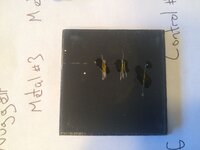Crispin
Silver Member
- Jun 26, 2012
- 3,584
- 2,856
- Detector(s) used
- Coinmaster Pro, Sand Shark
- Primary Interest:
- Other
You make the call: I did some things out of order but will clarify. I wrote controls because I thought they might be Aluminum but some were not. Aluminum and iron dissolve in nitric acid.

metal blob pendant:

metal eagle:

metal nut ring:

metal found in Bahamas, thought to be a cob:

unknown metal blob that kicked everything off:

1/2 reales found together:

.999silver that came with test kit, test right of it, turned dark red:

Ring stamped sterling, test to the right of ring:

Iron completely dissolved:

So there you have it folks. What I got on my hands is not Aluminum, some degree of silver in it. Of note, I tested a ring I thought was gold and it completely dissolved . Passed silver test and failed gold. Keep it mind I found most of these things in the same spot. Fire on a spanish ship is my guess...
. Passed silver test and failed gold. Keep it mind I found most of these things in the same spot. Fire on a spanish ship is my guess...

metal blob pendant:

metal eagle:

metal nut ring:

metal found in Bahamas, thought to be a cob:

unknown metal blob that kicked everything off:

1/2 reales found together:

.999silver that came with test kit, test right of it, turned dark red:

Ring stamped sterling, test to the right of ring:

Iron completely dissolved:

So there you have it folks. What I got on my hands is not Aluminum, some degree of silver in it. Of note, I tested a ring I thought was gold and it completely dissolved
 . Passed silver test and failed gold. Keep it mind I found most of these things in the same spot. Fire on a spanish ship is my guess...
. Passed silver test and failed gold. Keep it mind I found most of these things in the same spot. Fire on a spanish ship is my guess...Attachments
Last edited:










 At this point I dont even know if his finds are in Florida or Maine. Surely you must realize that I am not asking for an exact location.. I could care less. I was trying to help.
At this point I dont even know if his finds are in Florida or Maine. Surely you must realize that I am not asking for an exact location.. I could care less. I was trying to help.




